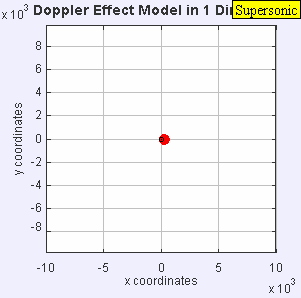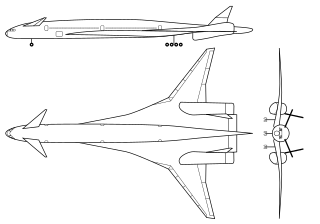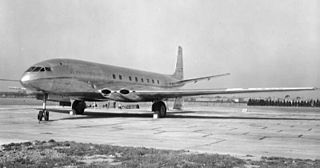
Concorde is a retired Anglo-French supersonic airliner jointly developed and manufactured by Sud Aviation and the British Aircraft Corporation (BAC). Studies started in 1954, and France and the United Kingdom signed a treaty establishing the development project on 29 November 1962, as the programme cost was estimated at £70 million . Construction of the six prototypes began in February 1965, and the first flight took off from Toulouse on 2 March 1969. The market was predicted for 350 aircraft, and the manufacturers received up to 100 option orders from many major airlines. On 9 October 1975, it received its French Certificate of Airworthiness, and from the UK CAA on 5 December.

The Tupolev Tu-144 is a Soviet supersonic passenger airliner designed by Tupolev in operation from 1968 to 1999.

The Whitcomb area rule, named after NACA engineer Richard Whitcomb and also called the transonic area rule, is a design procedure used to reduce an aircraft's drag at transonic speeds which occur between about Mach 0.75 and 1.2. For supersonic speeds a different procedure called the supersonic area rule, developed by NACA aerodynamicist Robert Jones, is used.

Supersonic speed is the speed of an object that exceeds the speed of sound (Mach 1). For objects traveling in dry air of a temperature of 20 °C (68 °F) at sea level, this speed is approximately 343.2 m/s. Speeds greater than five times the speed of sound (Mach 5) are often referred to as hypersonic. Flights during which only some parts of the air surrounding an object, such as the ends of rotor blades, reach supersonic speeds are called transonic. This occurs typically somewhere between Mach 0.8 and Mach 1.2.

The sound barrier or sonic barrier is the large increase in aerodynamic drag and other undesirable effects experienced by an aircraft or other object when it approaches the speed of sound. When aircraft first approached the speed of sound, these effects were seen as constituting a barrier, making faster speeds very difficult or impossible. The term sound barrier is still sometimes used today to refer to aircraft approaching supersonic flight in this high drag regime. Flying faster than sound produces a sonic boom.

The Boeing 2707 was an American supersonic passenger airliner project during the 1960s. After winning a competition for a government-funded contract to build an American supersonic airliner, Boeing began development at its facilities in Seattle, Washington. The design emerged as a large aircraft with seating for 250 to 300 passengers and cruise speeds of approximately Mach 3. It was intended to be much larger and faster than competing supersonic transport (SST) designs such as Concorde.

A sonic boom is a sound associated with shock waves created when an object travels through the air faster than the speed of sound. Sonic booms generate enormous amounts of sound energy, sounding similar to an explosion or a thunderclap to the human ear.

A supersonic transport (SST) or a supersonic airliner is a civilian supersonic aircraft designed to transport passengers at speeds greater than the speed of sound. To date, the only SSTs to see regular service have been Concorde and the Tupolev Tu-144. The last passenger flight of the Tu-144 was in June 1978 and it was last flown in 1999 by NASA. Concorde's last commercial flight was in October 2003, with a November 26, 2003 ferry flight being its last airborne operation. Following the permanent cessation of flying by Concorde, there are no remaining SSTs in commercial service. Several companies have each proposed a supersonic business jet, which may bring supersonic transport back again.

Sud Aviation was a French state-owned aircraft manufacturer, originating from the merger of Sud-Est and Sud-Ouest on 1 March 1957. Both companies had been formed from smaller privately owned corporations that had been nationalized into six regional design and manufacturing pools just prior to the Second World War.

The Boeing Sonic Cruiser was a concept jet airliner with a delta wing–canard configuration. It was distinguished from conventional airliners by its delta wing and high-subsonic cruising speed of up to Mach 0.98. Boeing first proposed it in 2001, but airlines generally preferred lower operating costs over higher speed. Boeing ended the Sonic Cruiser project in December 2002 and shifted to the slower but more fuel-efficient 7E7 airliner.

The Jet Age is a period in the history of aviation defined by the advent of aircraft powered by jet turbine engines and the social and cultural changes fostered by commercial jet travel.

A supersonic aircraft is an aircraft capable of supersonic flight, that is, flying faster than the speed of sound. Supersonic aircraft were developed in the second half of the twentieth century. Supersonic aircraft have been used for research and military purposes, but only two supersonic aircraft, the Tupolev Tu-144 and the Concorde, ever entered service for civil use as airliners. Fighter jets are the most common example of supersonic aircraft.

The Oklahoma City sonic boom tests, also known as Operation Bongo II, refer to a controversial experiment, organized by the Federal Aviation Administration (FAA), in which 1,253 sonic booms were generated over Oklahoma City, Oklahoma, over a period of six months starting in February 1964. The experiment was intended to quantify the effects of transcontinental supersonic transport (SST) aircraft on a city, to measure the booms' effect on structures and public attitude, and to develop standards for boom prediction and insurance data.
Wallace Dean Hayes was a professor of mechanical and aerospace engineering at Princeton University and one of the world's leading theoretical aerodynamicists, whose numerous and fundamental contributions to the theories of supersonic and hypersonic flow and wave motion strongly influenced the design of aircraft at supersonic speeds and missiles at hypersonic speeds. This greatly enhanced the development of supersonic flight and supersonic aircraft design.

Quiet Spike was a collaborative program between Gulfstream Aerospace and NASA's Dryden Flight Research Center to investigate the suppression of sonic booms. The patent was published with the United States Patent and Trademark Office in 2004 and is owned by Gulfstream Aerospace.

The High Speed Civil Transport (HSCT) was the focus of the NASA High-Speed Research (HSR) program, which intended to develop the technology needed to design and build a supersonic transport that would be environmentally acceptable and economically feasible. The aircraft was to be a future supersonic passenger aircraft, baselined to cruise at Mach 2.4, or more than twice the speed of sound. The project started in 1990 and ended in 1999.
The Gulfstream X-54 is a proposed research and demonstration aircraft, under development in the United States by Gulfstream Aerospace for NASA, that is planned for use in sonic boom and supersonic transport research.
The Zero Emission Hyper Sonic Transport or ZEHST is a planned hypersonic passenger jet airliner project by the multinational aerospace conglomerate EADS and the Japanese national space agency JAXA.

The Lockheed Martin X-59 Quesst, sometimes styled QueSST, is an American experimental supersonic aircraft under development by Skunk Works for NASA's Low-Boom Flight Demonstrator project. Preliminary design started in February 2016, with the X-59 planned to begin flight testing in 2021. After delays, as of January 2024, it is planned to be delivered to NASA for flight testing in 2024. It is expected to cruise at Mach 1.42 at an altitude of 55,000 ft (16,800 m), creating a low 75 effective perceived noise level (EPNdB) thump to evaluate supersonic transport acceptability.

The Boom Overture is a proposed supersonic airliner under development by Boom Technology. Its design will be capable of traveling Mach 1.7, with 64–80 passengers depending on configuration, and 4,250 nmi of range. The Overture is planned to be introduced in 2029. The company claims that with 500 viable routes, there could be a market for up to 1,000 supersonic airliners with fares similar to business class. The aircraft is planned to have a delta wing configuration, but will be built with composite materials. Following a redesign revealed in 2022, it is intended to be powered by four dry (non-afterburning) 35,000 lbf (160 kN) turbofans.



















